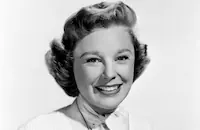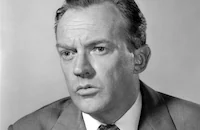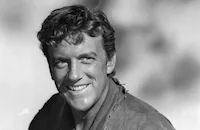The Girl in White

Brief Synopsis
Cast & Crew
John Sturges
June Allyson
Arthur Kennedy
Gary Merrill
Mildred Dunnock
Jesse White
Film Details
Technical Specs

Synopsis
In turn of the century New York, Emily Dunning desperately searches for a physician for her pregnant mother. Because they are new to the neighborhood, Emily cannot find an available doctor until someone directs her to a nearby office. Although hesitant because the physician is a woman, Dr. Marie Yeomans, Emily takes her home. Despite everyone's reservations, "Yeomy" successfully performs a caesarian on Mrs. Dunning, earning Emily's sincere admiration. Years later, Emily herself wants to become a doctor. Although Yeomy, who has become a close friend, warns her of the problems a female physician faces, Emily steadfastly begins her studies at Cornell. As a pre-med student, Emily encounters prejudice from most of the male students and professors, but attracts the attention of fellow medical student Ben Barringer. The two fall in love, and on the eve of their graduation, Ben proposes. Emily, who is second in her class, plans to continue studying at Cornell's New York medical college, but Ben, who is going to Harvard, wants her to quit. Despite her love for Ben, Emily refuses to give up her dream, and the two part. Emily lives with Yeomy while attending medical school, but finds that, like Yeomy, she is unable to obtain an internship. A visit to Dr. Seth Pawling, director of New York's Gouverneur Hospital, confirms her fear that women are not wanted by any hopsital. Discovering that Emily was third in her class, Yeomy goes to the hospital commissioner and suggests that public opinion, which favors granting internships to females, might go against him if people knew that Emily was turned down while men with mediocre academic records received jobs. Soon, newspapers announce that Emily is the first female to receive an appointment at a New York City hospital. When she arrives at her assignment at Gouverneur, Pawling tells her that he still feels the same way and warns that she will have a lot of ambulance duty. Later, she is happy to find that Ben is also interning at Gouverneur. Her first night on ambulance duty, New Yorkers are shocked to see a woman doctor, but she wins the admiration of ambulance driver Alec, as well as that of a large male patient whose dislocated arm she sets. Soon, Emily's hard work and dedication wins the respect of female nurses and many of the male doctors who had petitioned against her. She and Ben grow closer and he shows her his experiments in radium, revealing that he wants to pursue a career in research, rather than general practice. Despite Emily's successes, senior intern Dr. Graham will not accept her. One night, when one of the interns cannot take his shift, Graham assigns Emily, even though she has just finished a shift. When Graham examines a comatose male patient, he pronounces him dead and refuses to listen to Emily's suggestion that they might revive him. After Graham leaves, Emily asks her friend, Nurse Jane Doe, to assist her, and together they perform artificial respiration on the man. Working tirelessly, Emily is able to revive him, but knows that he must be kept awake. With the help of many of the nurses, Emily keeps the man walking for hours. One of the nurses is so impressed with what Emily has done that she calls a reporter and tells him the story. Pawling and Ben arrive back at the hospital just as reporters are taking pictures. Sensing Pawling's disapproval, an exhausted Emily lashes out at him and the hospital. Later, Emily tells Ben that she is quitting, but he urges her to stay, saying that Pawling is not the unfeeling person she thinks. When Emily is called into Pawling's office, he compliments her on a job well done and takes Graham to task. On her first Sunday off, Emily and Ben go to the beach together, and he becomes concerned over her questions about Pawling. Ben then asks her to an upcoming party celebrating Pawling's first anniversary as director of the hospital. On the night of the party, Pawling and Emily dance together and Ben suspects that they have fallen in love, even though Emily denies it. Later, Emily talks with Pawling, who says that he admires her as a doctor and a woman. As they are talking, Ben interrupts to report that two cases of typhoid have just been brought into the hospital. For days, the hospital is pushed to capacity coping with the epidemic. More doctors are requested, and Yeomy is assigned to Gouvernour. Emily is delighted to have her old friend stay with her, and Pawling and Ben come to realize that Yeomy, whose books he had read, not realizing she was a woman, is an excellent doctor. As the crisis passes, Ben reveals to Emily that he has received a fellowship to study in Paris. Emily confides her anxiety to Yeomy, who tells her that she should not deny herself a personal life. Yeomy also tells Ben not to give up too easily on Emily. A short time later, Emily is summoned when Yeomy collapses in one of the wards. By the time Emily arrives, Yeomy has died from a long-standing heart condition. Pawling tells Emily how much he had grown to admire Yeomy, then uses words similar to Yeomy's, encouraging Emily not to ignore her personal life, as he had done. A few moments later, Emily sees Ben in the hallway as he is about to leave for Paris. While talking, they suddenly kiss and admit that they have always loved each other. Emily then tells Ben to leave, but promises to wait for him.

Director

John Sturges
Cast

June Allyson

Arthur Kennedy

Gary Merrill

Mildred Dunnock

Jesse White

Marilyn Erskine

Guy Anderson
Gar Moore
Don Keefer
Ann Tyrrell

James Arness
Curtis Cooksey
Carol Brannon
Ann Morrison
Jo Gilbert
Erwin Kalser
Kathryn Card
Jonathan Cott
Joan Valerie
Coleman Francis
A. Cameron Grant
David Fresco
Susan Mary Odin
Teddy Driver
Elizabeth Flournoy
Ralph Peters
Robert Foulk
Betty Farrington
Harry W. Brown
Wheaton Chambers
Fred Datig Jr.
Dan Foster
Dean Dillman
Jim Cronan
James Thomas
Robert Board
Lyle Clark
Vernon Rich
Creighton Hale
Patrick Conway
Michael Pat Donovan
Ned Glass
Wymer Gard
Everett Glass
Bradley Mora

Kay English
Myron Welton
Bert Lebaron
Harry Strang
Frank Sully
Benny Burt
Nesdon Booth
Paul Kruger
Bee Humphries
Kate Mackenna
Phil Schumacher
Emory Parnell
Dick Simmons
Eddie Foster
David Fresco
Wilson Wood
Anthony Merrill
John Mckee
Don Anderson
Rudy Lee
Ralph Montgomery
Ralph Littlefield
Crew
Peter Ballbusch
Dr. Harold O. Cooperman
Armand Deutsch
Joe Edmundson
Cedric Gibbons
A. Arnold Gillespie
Sydney Guilaroff
Ralph Hurst
Warren Newcombe
David Raksin
Helen Rose
Douglas Shearer
Gile Steele
Philip Stevenson
Jerry Thorpe
William Tuttle
Leonid Vasian
Allen Vincent
Paul C. Vogel
Irmgard Von Cube
Irmgard Von Cube
Ferris Webster
Edwin B. Willis

Videos
Movie Clip


Hosted Intro
Film Details
Technical Specs

Articles
The Girl in White
Dunning was undeterred, of course, but her path wasn't easy. And if The Girl in White makes her struggle look glossier and more picturesque than it must have been in real life, it does a reasonable job of outlining the types of challenges Dunning faced - not to mention that Allyson makes a very sympathetic heroine. A haughty male doctor tries to trip her up by declaring a man dead and stalking off to handle other "more important" duties. Allyson's Dunning recognizes, pluckily, that the man is still alive but has suffered alcohol poisoning, and revives him with the help of a crew of nurses. Some of them are just heading out to a dance when they get the call that they're needed, so they throw their uniforms on over their evening gowns - a touch that's probably pure Hollywood, but is wonderfully effective and charming nonetheless.
Among those who worked on the screenplay for The Woman in White was Irma von Cube (then known as Irmgard von Cube), whose writing credits also include Johnny Belinda (1948) and Mayerling (1936). She and fellow writer Philip Stevenson adapted the script from Dunning Barringer's 1950 autobiography, Bowery to Bellevue: The Story of New York's First Woman Ambulance Surgeon. (Dunning Barringer died in 1961.) And if Allyson, already known for playing agreeable, effortlessly cheerful characters in movies like the 1944 Two Girls and a Sailor (opposite Van Johnson, who would become her romantic lead in a number of films made throughout the decade), seems like a not-quite-natural choice to play a groundbreaking doctor, she carries the role with agility and grace, never pushing too hard for dramatic effect. The Girl in White sets up a potential love triangle that's most likely fictional, in which a doctor whom Dunning knew in medical school (Arthur Kennedy's Ben Barringer) vies for her affections even as the director of Gouveneur Hospital (Gary Merrill's Dr. Seth Pawling), who'd at first been resistant to granting her a staff position, becomes fond of her. In the end, of course, it's Barringer who wins Dr. Dunning's heart, but Allyson gives some delicate texture to the romantic confusion; there are times you really believe she might choose the wrong guy.
And if the critic for the New York Times was lukewarm about the film, dismissing it mostly as "simply a subdued development of facets in a career," he did praise Allyson's performance, as well as those given by her co-stars: "The chief attributes of The Girl in White are its principals. Arthur Kennedy makes a genuinely authentic doctor devoted to research and the girl he wants desperately to marry. As that girl, June Allyson is serious about her work and her love. Although the script does not give her many opportunities for incisive acting, she does, on occasion, give Dr. Dunning the stature of a crusader."
Although Allyson had become a bona fide star in the 1940s, making movies in the postwar era presented new challenges. At that point, the studio system was breaking down, and not long after making The Girl in White, Allyson found herself adjusting to the changing times. "The only parental authority I had was the studio," Allyson said in a 1972 interview. "When I was a star, there was always somebody with me, to guard me. I was not allowed to be photographed with a cigarette, a drink, a cup of coffee or even a glass of water because someone might think it was liquor. When I left the studio I was already married and had two children, but I felt as sad as a child leaving home for the first time." In some ways, Allyson's portrayal of a pioneering doctor presaged that act of striking out for new territory in real life, which, in Allyson's case, included more movies, a fair amount of TV work, and even, in the 1970s, appearances on the Broadway stage. None of that, of course, is exactly the same as being an early 20th century woman doctor in a man's world. But playing a ground-breaking doctor brimming with self-determination probably wasn't bad practice for the new and more complicated postwar world.
SOURCES:
IMDb
The New York Times
National Library of Medicine (http://www.nlm.nih.gov/changingthefaceofmedicine/)
Producer: Armand Deutsch
Director: John Sturges
Screenplay: Philip Stevenson, Allen Vincent and Irma von Cube. Adapted from Emily Dunning's autobiography Bowery to Bellevue
Cinematography: Paul Vogel
Music: David Raksin
Film Editing: Ferris Webster
Cast: June Allyson (Dr. Emily Dunning), Arthur Kennedy (Dr. Ben Barringer), Gary Merrill (Dr. Seth Pawling), Mildred Dunnock (Dr. Marie Yeomans), Jesse White (Alec, ambulance driver)
[black-and-white, 92 minutes]
By Stephanie Zacharek

The Girl in White
Quotes
Trivia
Notes
The film's working titles were Bowery to Bellevue and Doctor Emily. A written prologue reads: "A pioneer is one who goes before to prepare the way for others. Emily Dunning, who lived in New York at the turn of the century, was a pioneer. This is her story." A July 17, 1951 Hollywood Reporter news item stated that Robert Walker was set to co-star in the film with June Allyson; however, Walker died in September 1951. Another Hollywood Reporter news item noted that Conrad Salinger was to write the film's score, but his contribution to the released film has not been determined.
As in the film, the real Dr. Emily Dunning Barringer (1876-1961) attended Cornell University in Ithaca, NY, then went on to attend Cornell's Medical School in New York City. The character of "Dr. Marie Yoemens" was fictional, although Barringer was influenced by pioneering female physician Dr. Mary Puttnam Jacobi. Barringer was the first woman intern at Gouverneur Hospital (part of New York City's Bellevue Hospital complex) and worked as an ambulance surgeon from 1903 to 1905. She married Dr. Benjamin Barringer and temporarily retired, but returned to the profession and continued to work as a physician for many years.
According to a July 21, 1952 Hollywood Reporter news item, freelance magazine writer Susan Alexander filed a $100,000 piracy suit against M-G-M, claiming that incidents in The Girl in White were taken from her Collier's magazine article "Riding for Trouble." Alexander further claimed that incidents within the film were from a treatment she submitted to the studio in 1948, rather than from Barringer's autobiography. Neither a date for Alexander's story nor the disposition of her suit has not been determined. Allyson recreated her role for a Lux Radio Theatre broadcast on May 18, 1953. The program also starred Steve Forrest and Dan Riss.
















